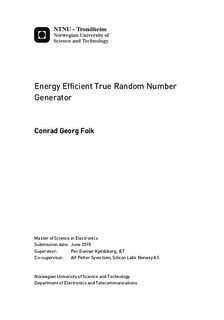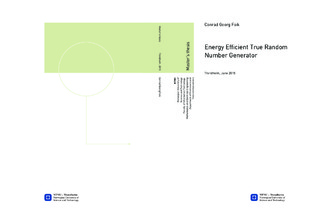| dc.description.abstract | For modern cryptography, the availability of true random numbers is indispensable. While recent technology trends require secure communication, they combine this requirement with the need for energy efficient solutions. As a result, true random number generators (TRNG) which satisfy both aspects have to be developed.
Based on this motivation, the here presented project has been focused on the realization of a TRNG for a mixed-signal microcontroller unit (MCU) environment. These kind of MCUs generally contain an analog-to-digital converter (ADC), which is well known to be influenced by random noise processes, as for example thermal noise. To avoid unnecessary design and prototype costs, it is therefore reasonable to try to implement the entropy source of a TRNG based on the existing ADC design. Possible non-random imperfections in the output of the source can be mask by deterministic post-processor algorithms. Two possible post-processors are the von Neumann corrector (VNC) and an extractor based on pairwise independent hash functions (IHF).
To evaluate the proposed concept, during this project the ADC of a typical MCU has been set up to function as an entropy source. The so generated data has been used as a basis for further simulations and analyses of the statistical characteristics of different TRNG designs. To ease these analyses, a novel test has been developed, which can be used to test a bit stream for the existence of special statistical characteristics, required by the VNC.
In addition, both the VNC and IHF have been analyzed with regard to their complexity and implemented in SystemVerilog. In order to find an energy efficient implementation of the IHF, two different algorithmic solutions have been considered and the chosen design has been kept generic to be tunable. For the VNC different approaches of clock gating have been explored to reduce unnecessary dynamic power consumption. After the verification of the proposed designs, both post-processors have been synthesized in a standard 65nm technology, in order to estimate their power performance.
Finally, in connection with the ADC based source, both post-processor designs have been evaluated with regard to both randomness and energy performance. While the output of the approach using the VNC is classified as not random, the IHF based design passes the so called NIST test suite for random numbers, and can therefore be considered to be random. Hence the connection of the ADC based entropy source and the IHF depicts a functional TRNG solution. By tuning the IHF, it has been able to reach an approximated minimum energy consumption of 5.9nJ for this approach | |

